Upper Back Pain From Sitting at Desk All Day
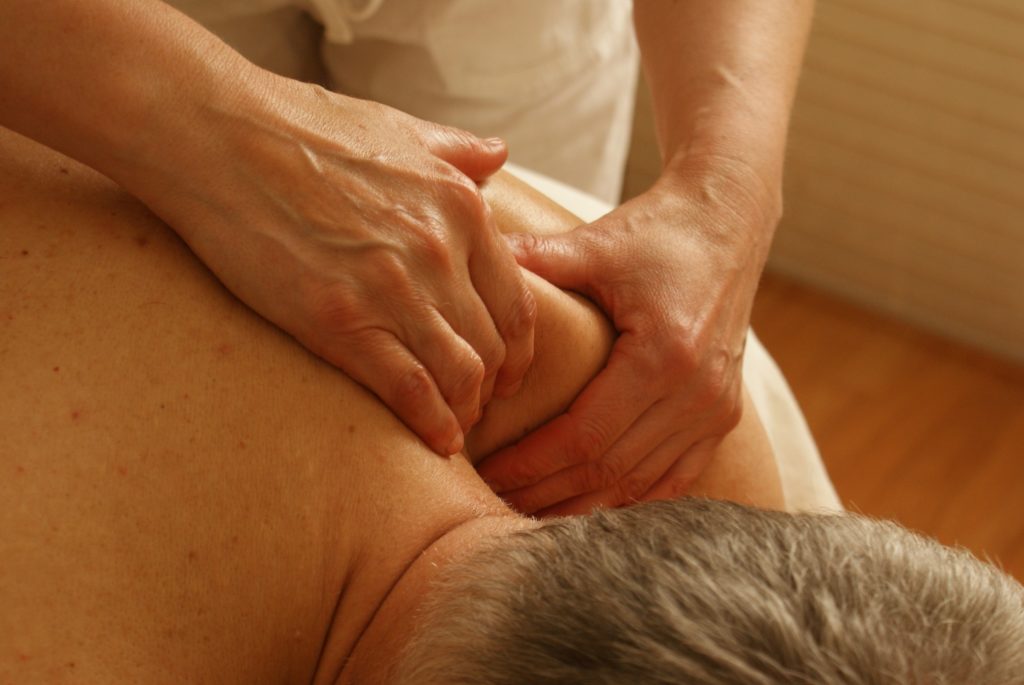
NOTE: Please use this information at your own risk. If you have a serious back issue do NOT do these and go see your doctor.
Around my early 20's I got my first real desk job. I worked in a high school and spent 40+ hours a week sitting down in a chair tutoring students and substitute teaching in New York. Right around this time is when I learned a fun truth about sitting — it's the fastest way to having a back that hurts like hell every day.
I had never previously had back pain in my life — I never had lower back pain, or shoulder issues, or neck pain, but suddenly I started having these pains simultaneously on the majority of my days at work. It didn't always last long, but every day at some point I was experiencing discomfort in my spine.
The worst part is that when you do get lower back pain,it seems so freaking hard to get rid of. You try adjusting your posture – still hurts.
You try rubbing it or massaging it or stretching out quickly — still hurts.
You try getting up and walking around — ten minutes later, it still hurts.
It's incredibly frustrating.
This article is a light-version of the video demonstrations in my course Back Pain Freedom, which goes into all of the three daily exercises I recommend.
Exclusive Bonus: Click here to download a bonus guide on fixing back pain that includes several other resources and techniques not featured here.
How to Get Rid of Lower Back Pain if You Think "My Back is Killing Me!"
According to the NIH (National Institute of Health) lower back pain affectsnearly everyone at some point in their life(!) .
Lower back pain also:
- Is something that Americans spend $50 billion dollars on annually in physicians visits and rehab
- The #1 cause of job related disability
- The #2 neurological health issue (headaches is #1)
Seeing as how back pain is such an ubiquitous problem, I was a little disappointed when I googled back pain relief, because this is the useless advice I got from just about every website.
Useless guides online to backpain:
- Surgery
- See a chiropractor
- Injections
- Physical Therapy
- Acupuncture
- Herbs
- Yoga
But here's the problem — none of these things you can do yourself , right now (unless you do the usual quick fixes like Aspirin, Ice, Icy/Hot, etc.).
So here's what I'm NOT going to tell you: I'm NOT going to tell you to go see XXX specialist, because that would be useless advice that you should already know. I am not a doctor or qualified medical professional. You should always be seeing them first.There are thousands of other websites telling you to just go see your doctor or a physical therapist. You know you should be doing that.
Instead, these are a few key strategies I've used to reduce the majority of my back pain on a day to day basis, but in my experience these are mostly short term fixes. Check out our epic guide to lower back pain relief to learn more about how I (and many others) got rid of most of my back pain on a daily basis.
4 Things You Can do Right Now For Lower Back Pain Relief
#1 The Egoscue Method For Your Lower Back
I can not even begin to describe my excitement upon finding the Egoscue method. The underlying premise is simple: you're experiencing pain because of chronic inactivity which weakens certain muscles and tightens others, and the promise is true: it works. Famous celebrities and pro athletes have raved about it, and if you don't believe me, just look at the Amazon reviews.
I'll go into much much more detail later, but for now, here are the exercises you should be doing (and the instructions):
For Lower Back Pain
A. Static back – Duration: 5-10 minutes
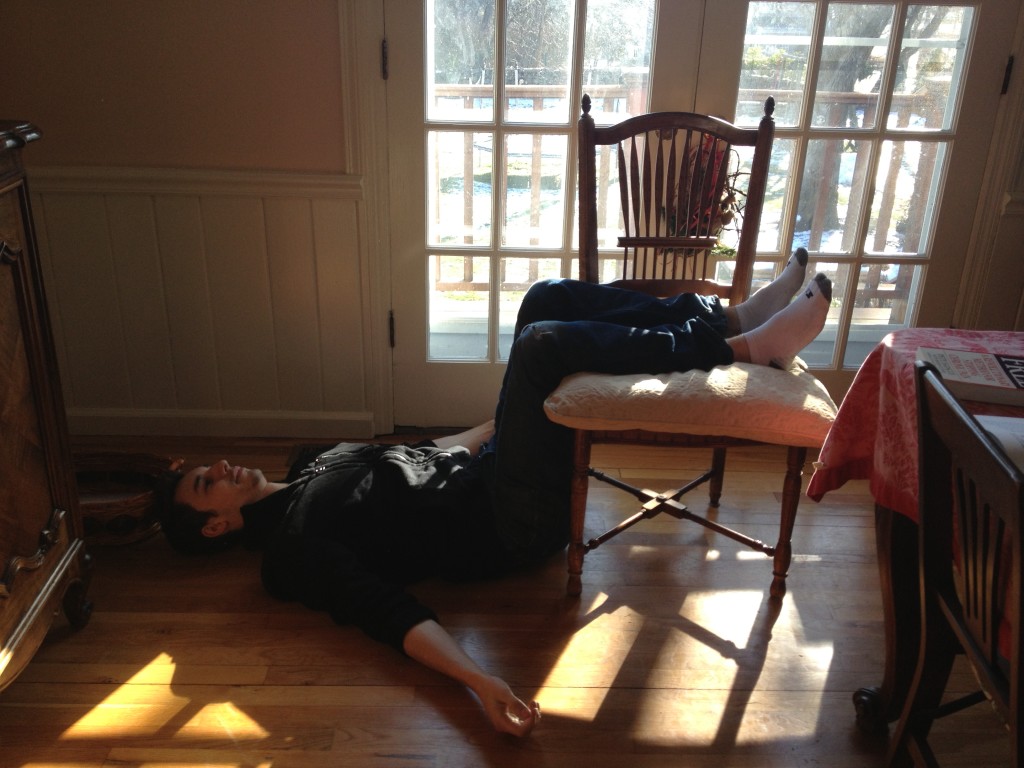
Static Back
How to do it:
- Lie on your back with both legs bent at right angles on a chair or block
- You can just rest your hands on your stomach or lay your arms out at the side below shoulder level, palms facing up
- Breathe from your stomach. Let the lower back relax.
- Hold for 5-10 minutes
Resources and tools mentioned:
- Pete Egoscue'sPain Free book
- The Theracane self-massage cane to reach hard spots
B. Static Extension – Duration: 1 Minute
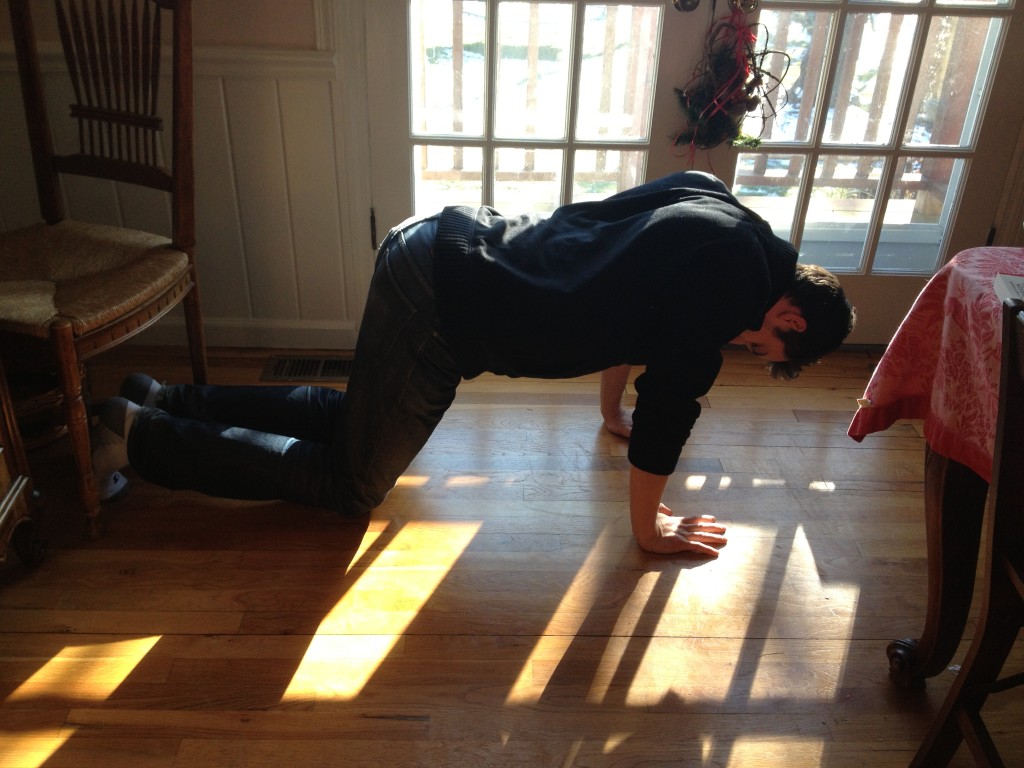
Static Extension on the Floor
For many of us, back pain is caused by the rounding of the back (flexion) from bad postural habits and sitting or slouching. This exercise reminds the back how to extend properly.
How to do it:
- Kneel with hands on the floor positioned under your shoulders
- Let your back and head relax towards the floor
- Let your shoulder blades come together, and make sure there is an arch in your back
- Keep the elbows straight but shift your hips forward 6 to 8 inches so they are not aligned with the knees.
- Hold 1-2 minutes
Resources and tools mentioned:
- Pete Egoscue'sPain Free book
- The Theracane self-massage cane to reach hard spots
C. Supine Groin Stretch – Duration: 10 minutes per side
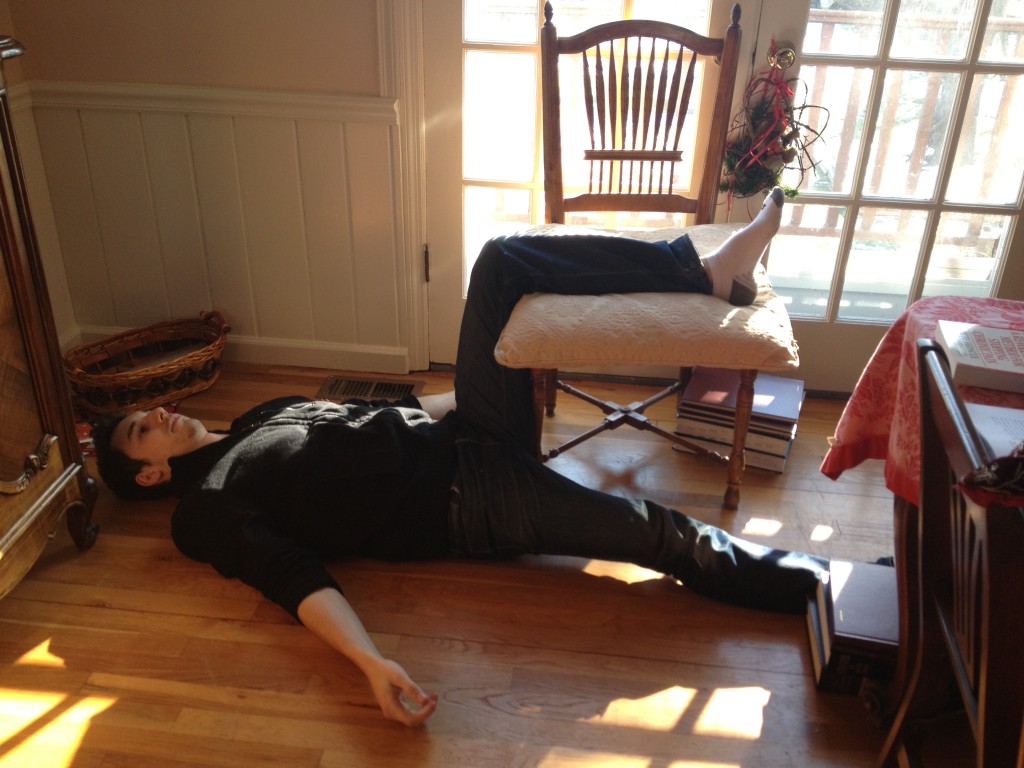
Supine Groin Stretch
How to do it:
- Lie on your back with one leg resting on a chair, knee bent at 90 degrees, while the other leg is extended straight out and resting on the floor
- Make sure both legs are aligned with the hips and shoulders
- The foot of the extended leg should be propped upright to preventing it from rolling to one side
- Hold 10 minutes then do it on the other side
Resources and tools mentioned:
- Pete Egoscue'sPain Free book
- The Theracane self-massage cane to reach hard spots
D. Modified Floor Block – Duration: 6 Minutes
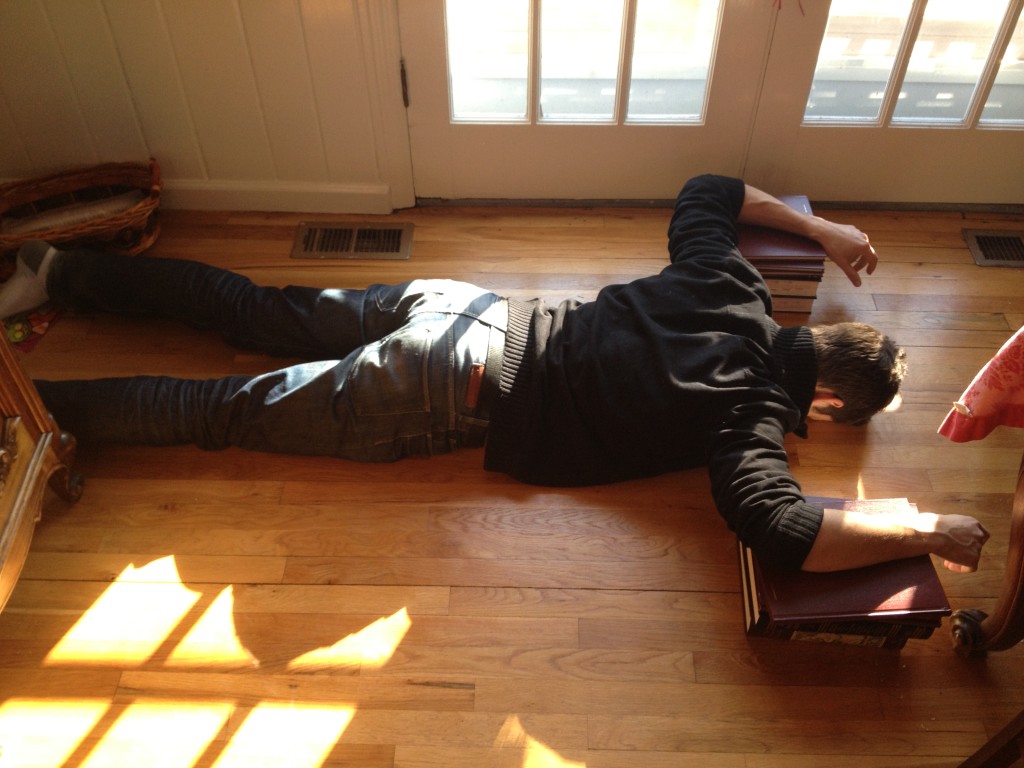
Floor Block Stretch
How to do it:
- Lie on your stomach with your forehead on the floor — your feet should be pigeon toed
- Rest your elbows on books or blocks so that your hands are in the "don't shoot!" position
- Make sure your shoulders are level — breathe deeply and relax the upper body
- Let your bodyweight naturally fall into the floor
- Hold 6 minutes
The Egoscue method is one thing I've constantly revisited because it works so well. Pro athletes and many celebrities have used it to eliminate lifelong, chronic pain (even after decades).
Resources and tools mentioned:
- Pete Egoscue'sPain Free book
- The Theracane self-massage cane to reach hard spots
#2 Trigger point Therapy for Fixing Lower Back Pain
The science behind trigger points suggests that many chronic pains in the body are due to tension in the musculature. Trigger points are essentially the "origin" points of these pains, and the way to stimulate the relaxation of these points is deep (slightly painful) massage to relax the area.
The interesting thing about trigger points is that even though you think your pain may be coming from a certain area (e.g. your lower back or knee), vary rarely is that the case. Usually somewhere in the surrounding musculature there is something going wrong, rather than at the site of the pain. This is called referral pain and is important to remember. The place hurting is often just collateral damage.
Generally you stimulate the points 5-7 times during the day, for about 30 seconds – 1 minute at a time. Many people report complete back pain relief after regularly using trigger points throughout the day.
Trigger points are a little tricky though because they take some practice to find.
How to stimulate the points:
- When you find the point, it should be very tender and painful. Apply pressure using your thumb, knuckle, or tennis ball on a 7 (out of 1 to 10) pain scale.
- Apply firm pressure in sliding strokes, like you're trying to iron the area. Don't just apply pressure and hold it still. Only massage in one direction.
- Do 6 – 12 strokes per trigger point each session (don't overdo it). Repeat 6-12x a day.
- If you aren't getting relief you aren't stimulating the right points
Here are the points you are going to stimulate:
- Gluteus medius (middle-top of your butt)
- Deep Spinal Muscles (muscles running alongside the left of your spine) (Use a tennis ball)
- Quadratus lumborum (muscles coming from left to right around your back, under the rib cage) (Use a tennis ball too)
A. Gluteus Medius point (Watch this video first)
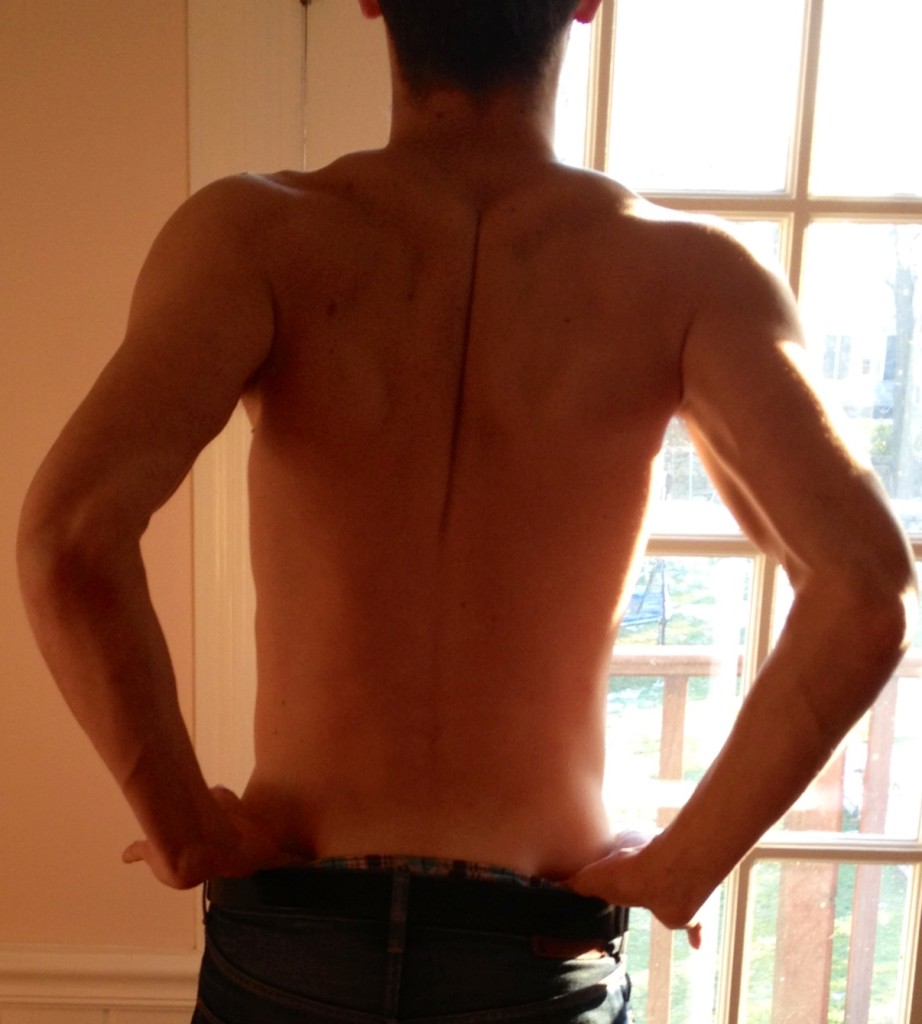
Stimulating Gluteus Medius Point With Fingers – Point B/C
How to find the gluteus medius points:
- Find the top of your hip bone (on your side) and put your hand on the muscle just below it, in other words, put your hand on the side of your hip.
- To locate the gluteus medius, shift your weight to one foot while you feel for a contraction just below the top of the hip bone. You should feel the muscle contract there which is basically the side of your butt (this is your gluteus medius)
- Follow this meaty part of your butt around to the back — remember it's just under your hip bone
- Apply hard pressure with your thumbs and poke around until you find a super tender, painful spot. Then follow the instructions above for stimulating the trigger points
Video explaining how to find these points:
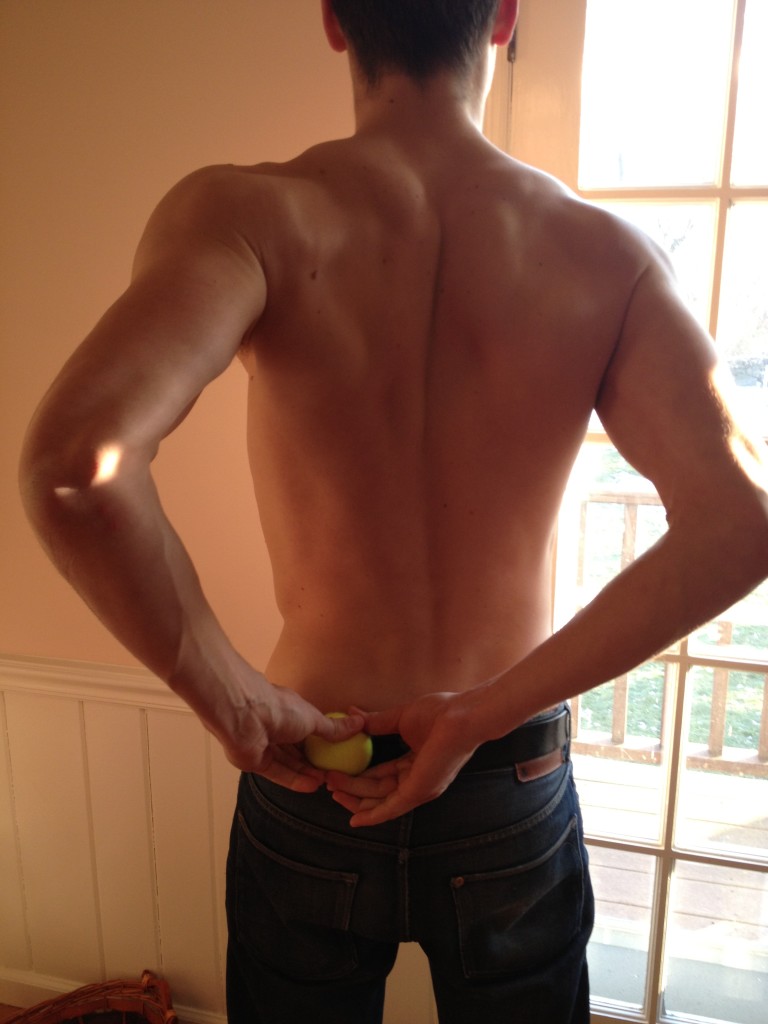
Stimulating Gluteus Medius Point With a Tennis Ball (Rub Against Wall or Lay Down)
Resources and tools mentioned:
- The Trigger Point Therapy Handbook
- The Theracane (for self-massaging hard points)
- The Trigger Point Therapy Ball
Using a tennis ball on the gluteus medius spot:
- You can also use a tennis ball and rub against the wall or lay on the floor, to stimulate the gluteus medius spot and apply firmer pressure and give the hands a break
- The gluteus medius point is usually around belt level, but it obviously depends how high or low you wear your pants. Just look for the soft fleshy top part of your butt (under the hip bone) and start applying hard pressure — you'll find a tender spot.
B. Deep Spinal Muscles
How to find/stimulate them:
- The deep spinal muscles are basically all the muscles running alongside the side of the spine. They are easy to find and stimulate.
- Grab a tennis ball and put your back up against the wall. Put the ball so it's placed just to the left of your spine, where there is a meaty muscular portion.
- Rub your back up and down the wall applying hard pressure with the tennis ball. Remember, it should hurt 😉
- Make sure that you're not applying pressure on the spine itself
Resources and tools mentioned:
- The Trigger Point Therapy Handbook
- The Theracane (for self-massaging hard points)
- The Trigger Point Therapy Ball
C. Quadratus lumborum
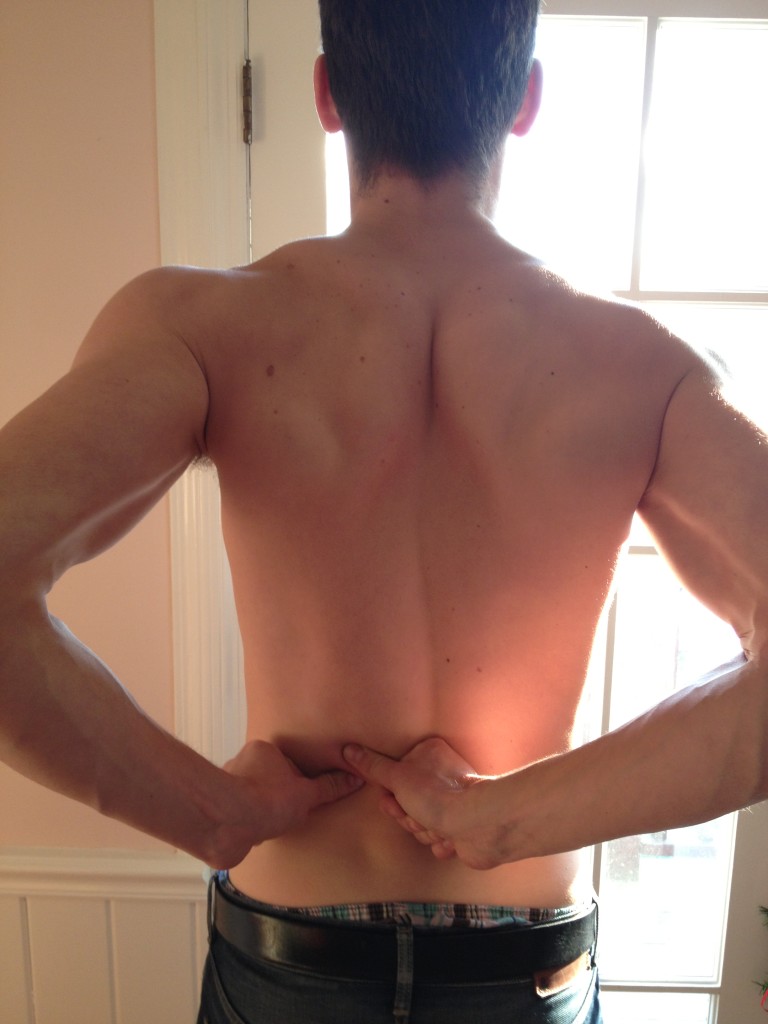
Quadratus Lumborum Point
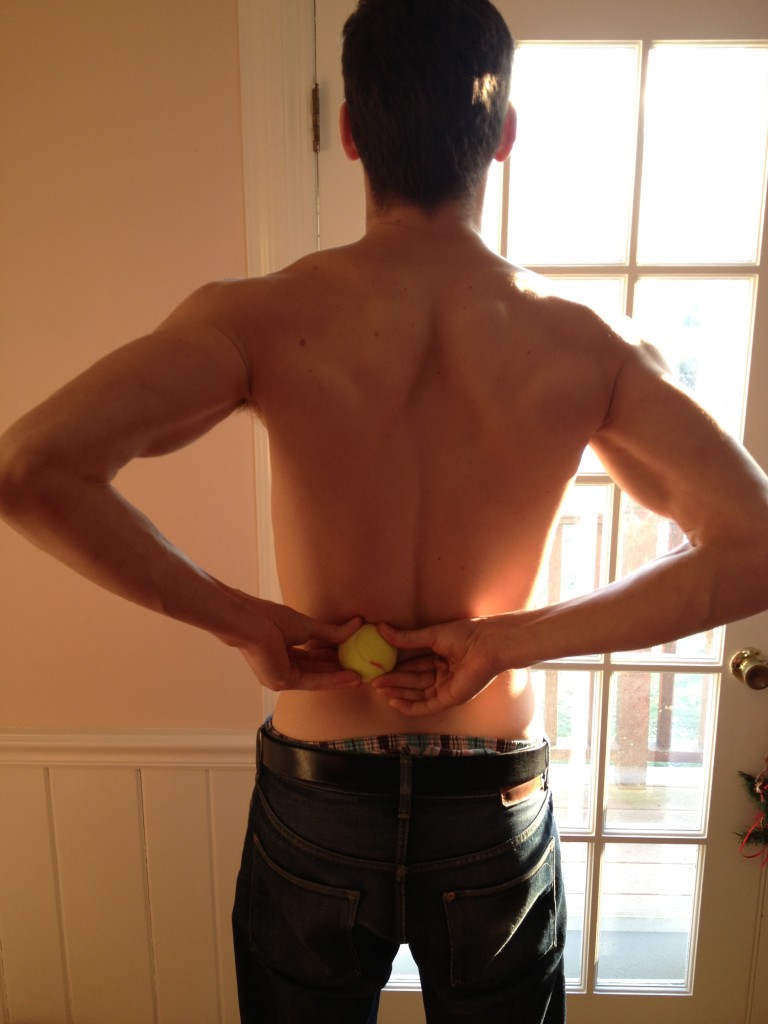
Stimulating Quadratus Lumborum By Pressing Against Wall With Tennis Ball or Laying Down
Here's how you find/stimulate it:
- The quadratus lumborum is pretty much where you think about your kidneys being.
- It's located right under your ribcage (between the rib cage and hip bone — see above) , and has a portion in the front of your body and back.
- To stimulate these points, either use your thumbs like above, or use a tennis balland roll horizontally — from the back of your body to the front, left and right. Not up and down.
- Basically place the tennis ball right under your rib cage on your back, and then apply pressure from left to right, horizontally.
Resources and tools mentioned:
- The Trigger Point Therapy Handbook
- The Theracane (for self-massaging hard points)
- The Trigger Point Therapy Ball
#3 Self Myofascial Release For Getting Rid of Lower Back Pain
Myofascial release is basically personal deep tissue massage. Most often a person will use a foam roller because it's an easy way to apply lots of pressure to an area and gently roll out areas with high amounts of tension.
Myo-fascial release falls into the category of deep-tissue massage or even trigger point therapy, meaning that the person will roll until they find a tender area, and then massage the area for 30 – 60 seconds before moving on.
Research has shown that massage and the use of pressure points (in combination with joint manipulation, exercise, and relaxation therapy) is effective for both acute and chronic lower back pain.
But then again you probably didn't really need to hear that — we all know how good it feels to lay down and have someone walk on our back when it's killing!
If your back is killing you, there are four places you should sit down and give yourself some myo-fascial release. You can either use a foam roller at your gym, buy one on Amazon, or use a tennis ball or even a baseball bat with a pillow over it. Get creative.
3 Places to Use Myo-fascial release – Time Required: 6 Minutes
A. Hip Flexors & Quads
Many people are told to stretch their hamstrings if their back is hurting, claiming that the hamstrings are what's tight. In reality, it's often the hip flexors that are the underlying cause — once you stretch the hip flexors they will release the tension on the hamstrings.
The reason for stretching these areas is that when they're tight, they alter the curvature in your lower back (which is crucial to keeping the weight evenly on your spine). Tight hamstrings or hip flexors will pull your pelvis out of proper alignment.
How to do it
- Get yourself in the position in the image above, and then slowly roll forward up to your waist until you find a tender point.
- Once you find a tender point, leave the foam roller there for 30 seconds, or very very slowly roll back and forth for the same duration
- Make sure to roll both near your groin (up where the top of your leg meets your hips — the hip flexors), as well as the length of the leg to stretch out the quads
- Duration: 30-60 seconds. 2 sets.
Resources and tools mentioned:
- The Trigger Point Therapy Handbook
- The Theracane (for self-massaging hard points)
- The Trigger Point Therapy Ball
- Foam roller for rolling out at the end of the night
B. Lower back / Thoracic Back
How to do it:
- Lay down with the foam roller in the middle of your back and then gradually roll it down to your butt, and up to your neck
- Focus on the area closer to the butt — where the gluteus medius trigger points are, the top meat of your butt
- Pause at tender areas for 30 – 60 seconds, or roll them very very slowly
- Duration 30-60 seconds. 2 sets.
Resources and tools mentioned:
- The Trigger Point Therapy Handbook
- The Theracane (for self-massaging hard points)
- The Trigger Point Therapy Ball
- Foam roller for rolling out at the end of the night
C. Hip Adductors
Stretching the hip adductors will help relax the muscles that are attached to the hips, which will remove some of the strain on the lower back when sitting/walking/doing athletics, and will help restore the natural curvature.
How to do it:
- Pull your leg out at a 90 degree angle, and roll along the inside of the leg. You are relaxing the adductor muscles which pull the legs together — they are often tight and keep the hips tight because we keep our legs together all day in a seated position.
- Roll along the length of the inner leg, and if you find a tender spot either pause, or roll very firmly but slowly.
- Duration – 30-60 seconds. 2 Sets
Resources and tools mentioned:
- The Trigger Point Therapy Handbook
- The Theracane (for self-massaging hard points)
- The Trigger Point Therapy Ball
- Foam roller for rolling out at the end of the night
#4 Static Stretches For Getting Rid of Lower Back Pain
Static stretches, like those done in Yoga, can be a fantastic way to alleviate lower back pain for two reasons: #1 you're relaxing areas that are constantly experiencing tension and getting more blood flow to them, and #2 you're lengthening areas that grow stiff and shortened from lack of daily use.
For those of you that sit 40 hours a week, doing these regularly will help immensely. Many of us slump our lower back throughout the day which puts improper pressure on the lower back. There should always be a curve in the lower back, and putting a pillow or lumbar support will reduce back pain and even referred pain in your legs or surrounding areas.
A. Hip Flexor Stretch
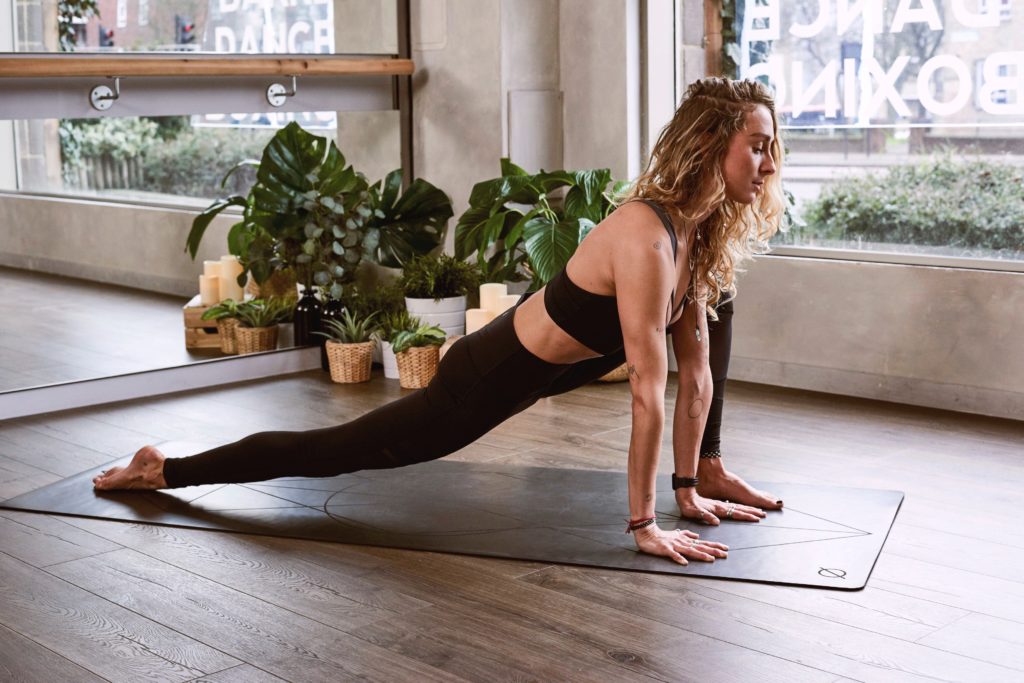
Pretty self explanatory, we all did it in gym class.
The only difference here is that you should befocusingon the feeling of your hip flexors stretching — and not much else. Your hip flexor is the vert top part of your leg right where it connects to your hip.
How to do this properly:
- Keep your back straight
- Focus on pushing the back leg up — you'll feel a harder stretch in your hip flexors
- Flex your butt and clench your abs
- To make this more difficult and more of a stretch, you can lean your upper body away from the back leg. So if it's your left leg that is elongated at the back, face your body right.
B. Runner's Quad Stretch

How to do this properly:
- Keep your back straight
- Clench your butt muscles hard
- Focus on the feeling of the top part of your leg stretching (the hip flexor). You'll also feel it all the way down near your knee if your quads are really tight
- This will help restore the natural curve in the lower back because tight quads and hip flexors pull the pelvis out of alignment
C. Child's Pose
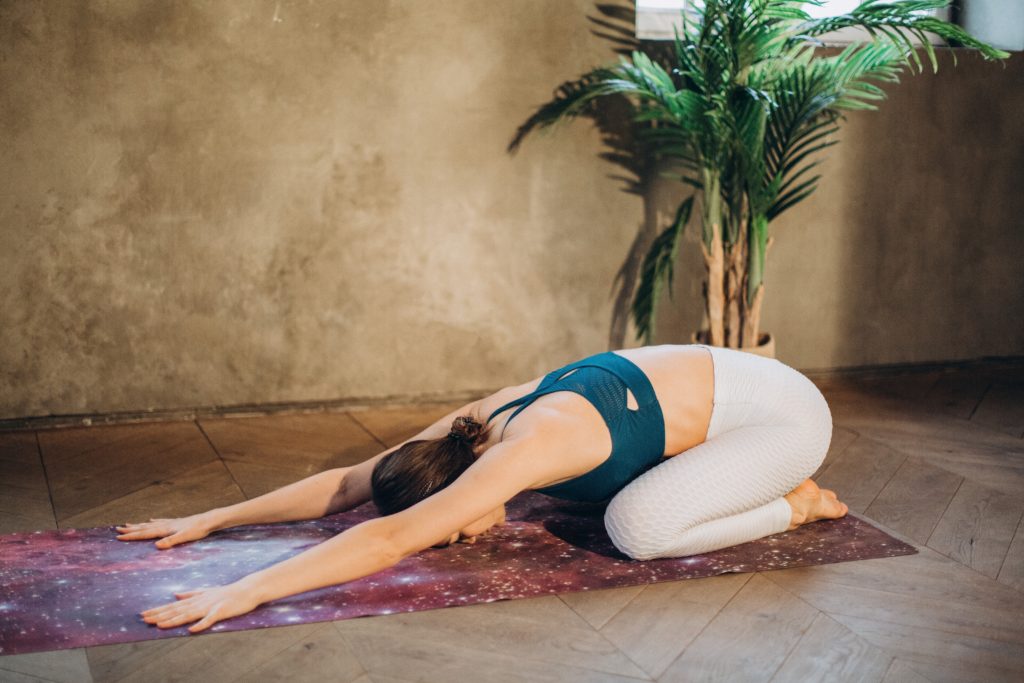
Do it because:It will help stretch out the upper and mid back, as well as open up the hips a bit. It also feels relaxing as hell.
Duration: 30 seconds, 2 repetitions.
D. Pigeon Pose

Do it because: It will stretch out those tight hips and your hamstrings. To make it easier, keep your foot more vertical (facing down). To make it harder and feel a deeper hip stretch, try pulling your foot out higher and more horizontal.
Duration: 30 seconds, 2 repetitions.
Other Resources I Recommend
#1 Tools I Use Daily – Theracane and Trigger Point Ball

The Theracane is the self-massage cane I've demonstrated in all these videos, and the primary reason I use it is because it's hard to get the traps, shoulders, and upper back on your own.
Another creative solution you can use is put a tennis ball into a sock, sling it over your shoulder, then roll against the wall.
For other parts on my body, I use a trigger point therapy ball. This is primarily something that I travel with, so I can use it while driving, on a plane, in hotels, etc.

#2 Inversion Table
I have no idea if there's scientific evidence supporting the use of inversion tables for lower back pain, but having recently purchased one for my dad, he said there has been a world of difference in the quick relief it can get.
Here's what they look like:

#3 Supplements That Lower Inflammation
One of the core supplements I usually recommend across the board is Fish Oil.
An interesting feature of back pain is that there are people with structural issues – who have no pain – and people with no structural issues, who have pain.
So it makes one wonder how much inflammation, the microbiome, stress, and emotions affect back pain.
Fish oil and other omega fatty acids help with inflammation, and weight loss too.
Curcumin is another supplement gaining major press lately about it's ability to lower inflammation in the body.
#4 Books That I Use Religiously
Pete Egoscue – Pain Free:

A few of the exercises demonstrated here are ones that I learned from the Egoscue method – one of the only things that has worked for me.
Consistently, after having spoken with chiropractors and doctors, who gave me zero useful advice about self-treating back pain, this book has come through.
You can read more about the bookPain Freeon Amazon here.
Trigger Point Therapy Workbook

The trigger point therapy workbook is a book I've used to learn where to self-massage using the Theracane (above) and the trigger point therapy ball mentioned above.
Personally, It's a really useful book for learning the locations to self-massage, as well as learning where pain gets referred from other areas.
You can read more about the Trigger Point Therapy Workbook Here.
*** Read part 2 and part 3 for fixing chronic back pain ***
Part 2: Why Cavemen Never Had Back Pain(Maybe)
Part 3: The Truth Behind Lower Back Pain
*****
Images: Back Pain – Dr Todd Cremeans,Foam Roller – Russelsteve, Hip Flexor Stretch, Hip Flexor Girl, Quad Stretch and Pigeon Pose- RachelV2007, Child's Pose – Allthatmel, Downward dog – Expertvillage
Sources:
- National Institute of Health –Low Back Pain Fact Sheet
- Pain Free – A Revolutionary Method for Stopping Chronic Pain (Amazon)
- Trigger point images from The Trigger Point Therapy Workbook – Davies et al.
- Massage for Low Back Pain – A Systematic Review – The Cochrane Collaboration
- NASM Essentials of Personal Fitness Training
- A Comparison of the Effects of Two Sitting Postures on Back Pain –Spine, Volume 16 Issue 10- Oct. 1991

Upper Back Pain From Sitting at Desk All Day
Source: https://modernhealthmonk.com/fixing-lower-back-pain/
0 Response to "Upper Back Pain From Sitting at Desk All Day"
Post a Comment